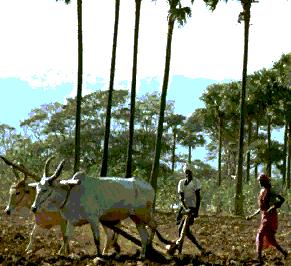- Language Description
- The Ways of Indo-Aryan Migrations (essay)
- Brahmi Script
- Indo-European Chronology (Indic)
Links
 One
of the main Ancient Indic languages, Sanskrit is not the direct descendant
of Vedic, as some may suppose. If Vedic was used
only as a dialect of North-Western India, Sanskrit was born in the North,
in the Gang valley, and was used at the time when Vedic still existed.
Sanskrit early became exactly a literature language, it was proclaimed
a "divine language" in India, and all classical works in science, verse
or history were written only in this language.
One
of the main Ancient Indic languages, Sanskrit is not the direct descendant
of Vedic, as some may suppose. If Vedic was used
only as a dialect of North-Western India, Sanskrit was born in the North,
in the Gang valley, and was used at the time when Vedic still existed.
Sanskrit early became exactly a literature language, it was proclaimed
a "divine language" in India, and all classical works in science, verse
or history were written only in this language.
Indians considered Sanskrit as a perfect language. But for Europeans it can seem too complicated. Its consonants, for example, form five blocks (dentals, labials, cerebrals, velar and palatal), which also have opposed vocied and unvoiced sounds, aspirated and non-aspirated ones. The rules of syllable conjugation and word combination structure are numerous and difficult.
Nouns have eight cases, all like in Proto-Indo-European, three genders and three numbers. The verb is characterized by a complicated system of moods and tenses, has the special derivative conjugation as well. Sanskrit syntax is not the same in all cases and depends on the type of the text.
There are in fact several types of Sanskrit: epic, classical, Buddhist
and Vedic Sanskrit. Many words in the language are not Indo-European and
were borrowed from aboriginal Dravidian and Munda languages. This makes
it farther from Iranian and other Indo-European
languages than was Vedic.